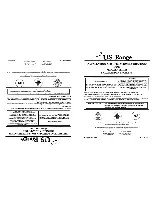
44
Installation and maintenance instructions 0020244997_07
12.11 Cleaning the condensate trap
1.
Remove the lower section from the condensate trap
(1)
.
2.
Flush out the lower section with water.
3.
Fill the lower section with water up to about 10 mm
below the upper edge.
4.
Attach the lower section to the condensate trap.
12.12 Cleaning the strainer in the cold water inlet
Validity:
Product with integrated hot water generation
1
2
1.
Close the cold-water isolation valve.
2.
Drain the product on the domestic hot water side.
3.
Unscrew the union nut
(2)
and the lock nut
(1)
from the
product's housing.
2
1
4.
Hinge the electronics box forwards.
5.
Remove the clamp
(2)
.
6.
Remove the pipe
(1)
from the product.
7.
Rinse the strainer under a jet of water, holding it
against the direction of flow.
8.
If the strainer is damaged or it can no longer be
cleaned sufficiently, you must replace the strainer.
9.
Refit the pipe.
10.
Reinsert the clamp.
11.
Always use new seals and retighten the union nuts and
the lock nut.
12.
Open the cold-water isolation valve.
12.13 Installing the compact thermal module
1
8
7
6
2
3
4
5
1.
Connect the compact thermal module
(2)
to the heat
exchanger
(1)
.
2.
Tighten the four new nuts
(8)
across the diagonal until
the burner flange fits closely and uniformly onto the
mating surfaces.
–
Tightening torque:6 Nm, if a torque spanner is
available
3.
Reconnect the plugs
(3)
to
(7)
.
4.
Connect the gas pipe using a new seal. In the process,
secure the gas pipe against twisting.
5.
Open the gas stopcock.
6.
Make sure that there are no leaks.
7.
Check that the sealing ring in the air intake pipe is posi-
tioned correctly in the seal seat.
8.
Reconnect the air intake pipe to the intake stub.
9.
Secure the air intake pipe with the retaining screw.
10.
Check the gas flow pressure.
12.14 Draining the product
1.
Close the service valves of the product.
2.
Start the check programme
P.06
(prioritising diverter
valve mid-position).
3.
Open the drain valves.
4.
Make sure that the cap of the automatic air vent on
the internal pump is open so that the product can be
drained fully.
12.15 Checking the pre-charge pressure for the
internal expansion vessel
1.
Close the service valves and drain the product.
2.
Measure the pre-charge pressure of the expansion
vessel at the vessel valve.
Condition
: Pre-charge pressure < 0.075 MPa (0.75 bar)
▶
Ideally, you should top up the expansion vessel with ni-
trogen. Otherwise, top it up with air. Ensure that the drain
valve is open when topping up.
3.
If water escapes from the valve of the expansion
vessel, you must replace the expansion vessel.
(
4.
Fill the heating installation. (
















































